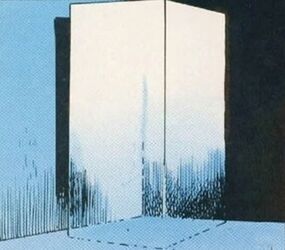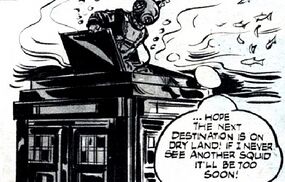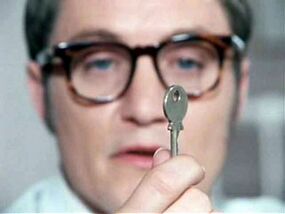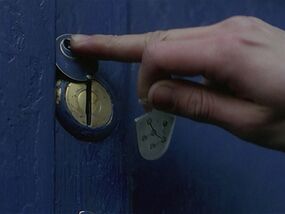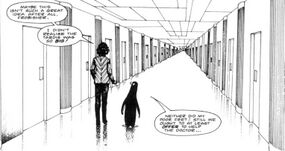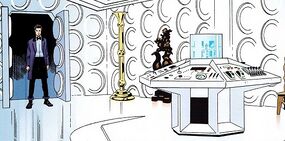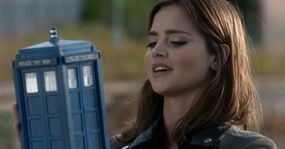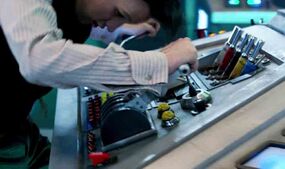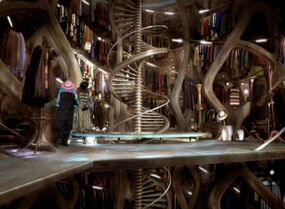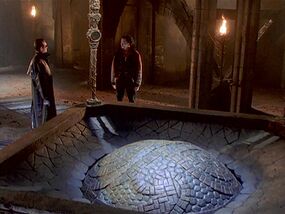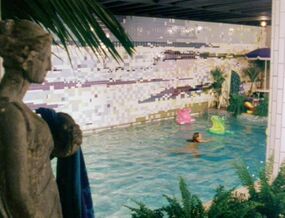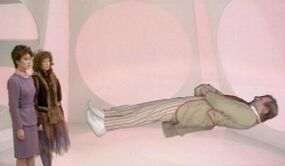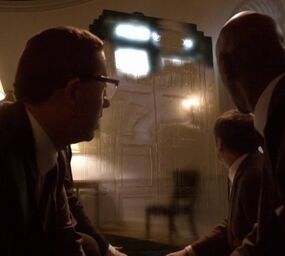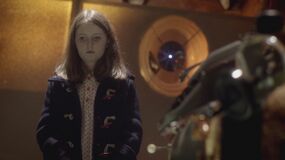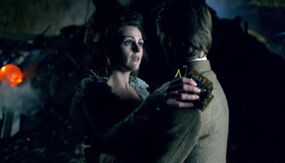The Doctor's TARDIS: Difference between revisions
(Added a name, Snog Box (as said by Clara Oswald).) Tags: Visual edit apiedit |
No edit summary Tags: Visual edit apiedit |
||
| Line 6: | Line 6: | ||
|first= An Unearthly Child (TV story) | |first= An Unearthly Child (TV story) | ||
|absent episodes= [[The Doctor's TARDIS - absent episodes|'''''see list''''']] | |absent episodes= [[The Doctor's TARDIS - absent episodes|'''''see list''''']] | ||
|alias = The Box, The Ship, Blue Box, Sexy, Old Girl, Snog Box | |alias = The Box, The Ship, Blue Box, Sexy, Old Girl, Snog Box, Blue Crate | ||
|clip = The Doctor is ridiculed - Classic Doctor Who - BBC | |clip = The Doctor is ridiculed - Classic Doctor Who - BBC | ||
|clip2 = Doctor Who Series 3 - Clip 1 | |clip2 = Doctor Who Series 3 - Clip 1 | ||
| Line 369: | Line 369: | ||
== Personality == | == Personality == | ||
In the first time, the [[First Doctor]] showed to be not fully aware of the conscience of his vessel, until its first attempt to communicate through faulties. ([[TV]]: ''[[The Edge of Destruction (TV story)|The Edge of Destruction]]'') Indeed, despite being a machine, the TARDIS was sentient and developed a personality. It was called "sentimental" by the [[Eighth Doctor]] ([[TV]]: ''[[Doctor Who (TV story)|Doctor Who]]'') and "stupid" by [[K9 Mark I]]. ([[TV]]: ''[[The Invasion of Time]]'') Though intelligent, it was usually unable to communicate in words with the Doctor. ([[TV]]: ''[[The Edge of Destruction]]'', ''[[The Runaway Bride]]'') Even when the TARDIS did not take the Doctor where he wanted to go, it took him where it felt he ''needed'' to be. ([[TV]]: ''[[The Doctor's Wife]]'') The [[Sixth Doctor]] considered "her" to be one of his most trusted companions. ([[GAME]]: ''[[Destiny of the Doctors]]'') | In the first time, the [[First Doctor]] showed to be not fully aware of the conscience of his vessel, until its first attempt to communicate through faulties. ([[TV]]: ''[[The Edge of Destruction (TV story)|The Edge of Destruction]]'') Indeed, despite being a machine, the TARDIS was sentient and developed a personality. It was called "sentimental" by the [[Eighth Doctor]] ([[TV]]: ''[[Doctor Who (TV story)|Doctor Who]]'') and "stupid" by [[K9 Mark I]]. ([[TV]]: ''[[The Invasion of Time]]'') Though intelligent, it was usually unable to communicate in words with the Doctor. ([[TV]]: ''[[The Edge of Destruction]]'', ''[[The Runaway Bride]]'') Even when the TARDIS did not take the Doctor where he wanted to go, it took him where it felt he ''needed'' to be. ([[TV]]: ''[[The Doctor's Wife]]'') The [[Sixth Doctor]] considered "her" to be one of his most trusted companions. ([[GAME]]: ''[[Destiny of the Doctors]]'') And it also started to cry in the Shroud of Sorrow, when the Doctor acused [[Clara's friend|Clara]] for calling the Tardis fat. | ||
The TARDIS had varying opinions of the Doctor's companions. It considered most of them to be strays and usually couldn't even remember their names, calling [[Amy Pond]] "the orangey girl" and [[Rory Williams]] "the pretty one". ([[TV]]: ''[[The Doctor's Wife (TV story)|The Doctor's Wife]]'') The only companion it showed a particular liking to was [[River Song]], although this was mainly because the TARDIS was, in a way, River's second mother since it had given her Time Lord DNA when River was conceived inside it. ([[TV]]: ''[[Let's Kill Hitler (TV story)|Let's Kill Hitler]]'') The TARDIS was prejudiced, liking River because it considered her to be its "child" but also showing dislike for "impossible" companions, notably [[Jack Harkness]] and [[Clara Oswin Oswald|Clara Oswald]], and it went to the end of the universe in an attempt to shake off Jack ([[TV]]: ''[[Utopia (TV story)|Utopia]]'') and refused to open for Clara ([[TV]]: ''[[The Rings of Akhaten (TV story)|The Rings of Akhaten]]'', ''[[Hide (TV story)|Hide]]'') The TARDIS had a tendency to be rather petty and spiteful to people it disliked and seemed to enjoy annoying Clara simply because Clara was impossible. The Doctor said the TARDIS was like a cat and was slow to trust. Clara once described the TARDIS as a "grumpy old cow". ([[TV]]: [[Hide (TV story)|''Hide'']]) However, upon discovering that Clara was the Doctor's saviour, having saved him millions of times in so many different lives, the TARDIS clearly realised it had misjudged her and no longer disliked her, protecting her when she was on the outside and even teaching her how to open its doors with a snap of her fingers, something only the Doctor and River could do before and an ability unique even among the Time Lords. ([[TV]]: [[The Day of the Doctor (TV story)|''The Day of the Doctor'']]'', [[The Time of the Doctor (TV story)|The Time of the Doctor]], [[The Caretaker (TV story)|The Caretaker]]'') | The TARDIS had varying opinions of the Doctor's companions. It considered most of them to be strays and usually couldn't even remember their names, calling [[Amy Pond]] "the orangey girl" and [[Rory Williams]] "the pretty one". ([[TV]]: ''[[The Doctor's Wife (TV story)|The Doctor's Wife]]'') The only companion it showed a particular liking to was [[River Song]], although this was mainly because the TARDIS was, in a way, River's second mother since it had given her Time Lord DNA when River was conceived inside it. ([[TV]]: ''[[Let's Kill Hitler (TV story)|Let's Kill Hitler]]'') The TARDIS was prejudiced, liking River because it considered her to be its "child" but also showing dislike for "impossible" companions, notably [[Jack Harkness]] and [[Clara Oswin Oswald|Clara Oswald]], and it went to the end of the universe in an attempt to shake off Jack ([[TV]]: ''[[Utopia (TV story)|Utopia]]'') and refused to open for Clara ([[TV]]: ''[[The Rings of Akhaten (TV story)|The Rings of Akhaten]]'', ''[[Hide (TV story)|Hide]]'') The TARDIS had a tendency to be rather petty and spiteful to people it disliked and seemed to enjoy annoying Clara simply because Clara was impossible. The Doctor said the TARDIS was like a cat and was slow to trust. Clara once described the TARDIS as a "grumpy old cow". ([[TV]]: [[Hide (TV story)|''Hide'']]) However, upon discovering that Clara was the Doctor's saviour, having saved him millions of times in so many different lives, the TARDIS clearly realised it had misjudged her and no longer disliked her, protecting her when she was on the outside and even teaching her how to open its doors with a snap of her fingers, something only the Doctor and River could do before and an ability unique even among the Time Lords. ([[TV]]: [[The Day of the Doctor (TV story)|''The Day of the Doctor'']]'', [[The Time of the Doctor (TV story)|The Time of the Doctor]], [[The Caretaker (TV story)|The Caretaker]]'') | ||
Revision as of 18:10, 12 April 2015
- You may be looking for the Doctor's first TARDIS.
The Doctor's TARDIS — sometimes called the Ship by the First Doctor, before then the Box, and most often known simply as the TARDIS (PROSE: Time and Relative, COMIC: Food for Thought) — was the Doctor's primary means of transport. It was capable of travelling through space and time. The Doctor voyaged in his vessel from the Big Bang (TV: Terminus, Castrovalva, AUDIO: Slipback) to the end of the universe. (TV: Utopia, Listen) The craft was also capable of travelling between parallel realities in spite of the fact that it was not specifically designed for inter-dimensional travel. (TV: Rise of the Cybermen)
Other Time Lords frequently characterised the Doctor's TARDIS as woefully out-of-date. (TV: The Time Meddler, The Claws of Axos, The Ribos Operation) Indeed, by at least the time of the Doctor's fourth incarnation, if not much earlier, the model — called a "Type 40" — had been pulled from general service on Gallifrey. (TV: The Deadly Assassin, The Invasion of Time)
The craft was prone to a number of technical faults, ranging from depleted resources (TV: An Unearthly Child, The Wheel in Space, Vengeance on Varos) to malfunctioning controls (TV: The Edge of Destruction) to a simple inability to arrive at the proper time or location. (TV: The Visitation, Attack of the Cybermen, The Eleventh Hour, Victory of the Daleks, The Girl Who Waited and many others) However, because the TARDIS was a living being, these "faults" may instead have been at least partially attributed to the manifestation of the ship's free will. Indeed, the TARDIS itself once told the Eleventh Doctor that it may not have always taken him where he wanted to go, it had always taken him to where he needed to go. (TV: The Doctor's Wife)
As the centuries passed and all of the Doctor's companions came and went, his faithful TARDIS remained his constant companion. They shared an unbreakable bond, and the Doctor came to feel that in the end, it was just him and his TARDIS. (AUDIO: The Girl Who Never Was, TV: The Doctor's Wife) Such was this bond, that, in an alternate timeline, the TARDIS eventually became the Doctor's final resting place, containing his personal time stream. (TV: The Name of the Doctor)
Procurement
In his first incarnation, the Doctor implied he had built his TARDIS himself. (TV: The Chase) Whether there was some truth to this or not, he and others later stated that he had, in fact, stolen it. (TV: The War Games, Frontier in Space, Logopolis, Planet of the Dead, The Doctor's Wife, The Time of the Doctor; COMIC: The World Shapers) The TARDIS was once owned by the Time Lady Marianna (AUDIO: The Abandoned) and later by the Time Lord Marnal, and due to his exile at the time of the Doctor's procurement of the TARDIS, he claimed that the Doctor stole it. (PROSE: The Gallifrey Chronicles) Other accounts differ to this, and implied it came from the general, government-controlled "stockpile" of TARDISes after the model had been officially decommissioned. (TV: The Deadly Assassin, PROSE: The Exiles, COMIC: Time & Time Again) The Fourth Doctor told Adric that "it was in for repairs on Gallifrey when [he] borrowed it." When the Alzarian countered that he thought the Doctor outright owned the vehicle, the Doctor said, "Well, on a sort of 'finders, keepers' basis, yes." (TV: Logopolis)
When the Doctor first decided to leave Gallifrey, he had the chance to take a Type 53, but dismissed it as "soulless" in favour of the Type 40. (PROSE: Lungbarrow) The Doctor received a recommendation for this particular TARDIS from a version of Clara Oswald. (TV: The Name of the Doctor) The TARDIS itself said it was "a museum piece", though this may have been figurative. (TV: The Doctor's Wife)
None of these accounts precluded the possibility that he had somehow been responsible for its creation. Indeed, another account compromised between theft and creation. It claimed while the Doctor had not built the TARDIS from scratch, he had substantially modified/rebuilt it. According to this view he achieved control of the TARDIS without using a direct mental link. This let him bypass the feature on most TARDISes which sent a tracking signal to the Time Lords. (PROSE: The Taking of Planet 5) As a result, while the Doctor still had a significant mental link with the TARDIS early in his travels, such as when the ship assisted him with his first regeneration (TV: The Tenth Planet), he did not impose his will on it, allowing the TARDIS to go where it wished rather than exerting direct control.
These accounts notwithstanding, the most direct commentary on the Doctor's acquisition of the TARDIS came from the TARDIS itself. When House transferred the soul of the TARDIS into Idris, the TARDIS gave its side of the story. It confirmed it had been out of commission, a "museum piece", when the First Doctor met it. It also confirmed that the Doctor had stolen it, denying the Eleventh Doctor's attempt to characterise the action as "borrowing". It also stated that it had stolen him, and had no intention of ever giving him back. It was unlocked and had deliberately let him steal it because it wanted to explore the universe and sensed he would be an ideal match. When it asked the Eleventh Doctor what his first incarnation said upon seeing it, he recalled saying "you were the most beautiful thing I've ever known". (TV: The Doctor's Wife)
The Doctor's very first known encounter with the TARDIS actually occurred when he was a young boy. The TARDIS, piloted by Clara Oswald, had accidentally landed in the barn near where the young Doctor was sleeping. Although there is no indication that he saw it, he did awaken to the sound of its dematerialization. It is not as yet known whether the Doctor actually retains any memory of this, or whether this event played any role in his later procurement of the Type 40. (TV: Listen)
Model and type
The precise model number of the Doctor's TARDIS was a matter of some confusion, particularly when it was compared to those of other Time Lords. The Monk claimed to have a Mark IV TARDIS, while the Doctor had a Mark I. (TV: The Time Meddler) The dematerialisation circuit of the Master's TARDIS was a Mark II, compared to the Doctor's Mark I. (TV: Terror of the Autons) When the Teselecta scanned the Doctor's TARDIS, its records stated the timeship was a Type 40, Mark 3. (TV: Let's Kill Hitler)
During a visit by the Fourth Doctor to Gallifrey, the Doctor's TARDIS was unambiguously called a "Type 40". At that time, it was made clear that all other Type 40s had long since been officially decommissioned and replaced by newer models. The fact that the Doctor's TARDIS was a Type 40 was not common knowledge, even to the Castellan. (TV: The Deadly Assassin) This designation was used with greater frequency afterward. It was even used by the Eleventh Doctor as an excuse to Winston Churchill for his tardy response to Churchill's summons. (TV: Victory of the Daleks) When the TARDIS had the opportunity to speak to the Eleventh Doctor in the body of Idris, it called itself a "Type 40" without any qualification. (TV: The Doctor's Wife)
The Eleventh Doctor appeared to know his TARDIS' date of manufacture, as one chronicle indicated that he celebrated "her birthday". (PROSE: Dark Horizons)
Exterior
Almost all TARDISes were designed to blend into their surroundings by means of a mechanism usually called the "chameleon circuit", but occasionally the "camouflage unit". Some later models seemed to let the pilot choose a desired exterior, overriding what would have been "natural" for the surroundings. (TV: Time and the Rani, Time-Flight)
The Doctor's TARDIS would have had both abilities, were the chameleon circuit operational. Before he met Ian and Barbara, the First Doctor had landed on Iwa, where the TARDIS had posed as a boulder in that planet's desert. (PROSE: Frayed) On Quinnis, the First Doctor was unhappy when the TARDIS landed in a bazaar and chose to turn into a market stall, complete with a striped awning. (AUDIO: Quinnis) The Fourth Doctor showed Adric how the TARDIS could be changed to the shape of an Egyptian pyramid, implying he could override the chameleon circuit's "automatic" functionality. (TV: Logopolis) Susan mentioned the TARDIS had appeared as a sedan chair and an ionic column. (TV: "The Cave of Skulls")
In any case, the defining characteristic of the Doctor's TARDIS was that its chameleon circuit had broken after assuming the shape of a police box in 1963 London. (TV: "The Cave of Skulls") The Eleventh Doctor sabotaged the chameleon circuit before the TARDIS left 1963 London as part of a plot to foil the Prometheans so that the blue box shape was imprinted into the race memory of humanity. (COMIC: Hunters of the Burning Stone) Not knowing this, the First Doctor and Susan expressed surprise that it had not changed form when they arrived at a new destination. (TV: "The Cave of Skulls")
By his eleventh self, the Doctor was telling his companions that the chameleon circuit was working, but due to a fault, invariably assumed its customary police box shape:
It’s camouflaged. It’s disguised as a police telephone box from 1963. Every time the TARDIS materialises in a new location, within the first nanosecond of landing, it analyses its surroundings, calculates a twelve-dimensional data map of everything within a thousand-mile radius and then determines which outer shell would blend in best with the environment.... and then it disguises itself as a police telephone box from 1963.
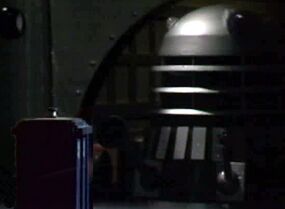
Friends and enemies could identify the TARDIS by its unvarying shape. The Daleks even used miniature copies of the TARDIS for target practice. (TV: Death to the Daleks) The Cybermen recognised it (TV: Earthshock), as did the Black Guardian's operative known as the Shadow. (TV: The Armageddon Factor) Sarah Jane also recognised it, which led to her reunion with the Tenth Doctor. (TV: School Reunion) Donna Noble was also on the look-out for the TARDIS. (TV: Partners in Crime)
On one occasion, an actual police box — namely, the last of its kind, which was situated on the Barnet by-pass — scared a group of invading aliens away from Earth when they mistook it for the Doctor's ship. (PROSE: Useless Things) Miss Kizlet's team faced "an embarrassment" when they thought the police box in Earl's Court the Doctor's space-time vehicle. (TV: The Bells of Saint John) Madge Arwell confused a normal police box for the TARDIS while helping the Eleventh Doctor find the TARDIS. (TV: The Doctor, the Widow and the Wardrobe) After accidently aiding the Trickster by preventing her parents' deaths, Sarah Jane sought out the TARDIS to get the Doctor's help; however, as she time traveled to the 1950s, Sarah Jane mistoke a regular police box for the TARDIS since they were "everywhere" at the time. (TV: The Temptation of Sarah Jane Smith)
Captain Jack Harkness was on the look-out for "a version of" the police box throughout the 20th and early 21st centuries to avoid meeting the Doctor before their initial meeting. (TV: Utopia) Members of LINDA also knew of the outer shape of the Doctor's TARDIS, as did the Abzorbaloff. (TV: Love & Monsters)
Because the police box shape was relatively easily recognised, the Doctor made several attempts to change the exterior of the TARDIS. None were particularly successful. In the end, he forewent changing how the TARDIS' outer shell looked by his ninth incarnation, deciding that he liked it. When Mickey Smith questioned the wisdom of leaving the TARDIS parked in the middle of Cardiff, thinking the appearance of a police box would draw unwanted attention, the Doctor reasons that it was not a concern--people would see a blue box in the middle of the city and walk past it, taking no further notice. (TV: Boom Town)
- These attempts are chronicled at chameleon circuit.
The exterior of the TARDIS changed shape when it entered siege mode. In this form, it took the shape of a cube etched with Gallifreyan writing with no way of getting in or out. If the TARDIS had insufficient power, this mode could not be turned off. (TV: Flatline)
Door
Generally, the TARDIS had two doors along one of the craft's four sides. They could open inward and outward. (TV: Time-Flight, The Ice Warriors, The Eleventh Hour, GAME :The Doctor and the Dalek) By the time of the Tenth Doctor, the doors could be opened by the snap of the fingers. (TV: Forest of The Dead, The Eleventh Hour, Day of the Moon) This was not exclusive to the Doctor, as at some point, companion Clara Oswald also attained this ability. (TV: The Day of the Doctor) The right-hand door had a lock. (TV: The Sensorites, Spearhead from Space and many others) On the left-hand door was a panel in which was a replica of a telephone used in real police boxes to summon the police. (TV: The Empty Child, The Bells of Saint John, The Time of the Doctor) Although during the Doctor's ninth incarnation this phone was (usually) non-functional, (TV: The Empty Child) by his eleventh incarnation the phone could be used to send and receive calls. (TV: The Day of the Doctor, The Time of the Doctor) A sign on this small door offered instructions on use of the phone. (TV: Logopolis) On most occasions, the left-hand door was set to a fixed position. Likewise, the windows on the door were most often seen in a closed position, though the First Doctor sometimes opened them. (TV: The Dalek Invasion of Earth)
There were exceptions to all these statements. The Second Doctor once entered through the top of the TARDIS, by lifting a panel on which the roof lamp rested. (COMIC: Peril at 60 Fathoms) He also tried to enter through the back panels, the occasional cat flaps and once through the central beacon. It was indicated that these would usually work, but did not in this case. (PROSE: Heart of TARDIS)
The lock was sometimes on the left-hand door, even though normal entry was still through the right. (TV: most serials prior to The War Machines)
The left-hand door was sometimes used for egress and the right-hand one stayed in a fixed position. (TV: The Aztecs)
Sometimes both doors could be pushed (TV: Rose, Father's Day) or pulled open. (TV: The Runaway Bride, The Beast Below, The Christmas Invasion)
The windows on the doors and around the exterior could be opened, at least during the First Doctor's tenure. (TV: "World's End", "Desperate Measures", "The Centre")
The emergency phone was sometimes on the right-hand panel while the Second Doctor inhabited the TARDIS, but by the time of his adventure on Dulkis, it had returned to the left-hand door. (TV: The Dominators)
During the Doctor's first incarnation, a faded St John Ambulance logo could be seen on the door, even though it was sometimes barely visible under a layer of paint. During his second incarnation, it was not present. (TV: The Dominators onwards) When the TARDIS regenerated itself at the start of his eleventh incarnation, a new St John sticker appeared on the door. (TV: The Eleventh Hour)
The exact wording on the sign on the telephone door varied slightly over time — once it, and the writing otherwise on the front of the TARDIS, was changed to read BAD WOLF. (TV: Turn Left) When the TARDIS "regenerated" consequent to the Tenth Doctor's regeneration, this sign became backlit. (TV: The Eleventh Hour onwards)
By the time he was going to have the chameleon circuit repaired by the Logopolitans, the Fourth Doctor had installed a handle on the telephone panel on the left-hand door. This remained a subtle, if functional, part of the design. (TV: The Empty Child)
At some point prior to arriving to his unexpected death in San Francisco, the Seventh Doctor affixed a small handle to the right-hand door. (TV: Doctor Who) This handle persisted after the "regeneration" of the TARDIS consequent to the arrival of the Eleventh Doctor. (TV: Rose onwards)
The Eleventh Doctor somehow fixed the TARDIS doors to accommodate his robotic T-Rex companion Kevin, although it was never explained how. (COMIC: When Worlds Collide)
If the TARDIS entered siege mode, the door disappeared entirely. (TV: Flatline)
Lock and key
- Main article: TARDIS key
Operation
Entry to the Doctor's TARDIS was usually effected by inserting a key into a lock, just as would be expected with a real police box. However, the lock did not respond to police-issued keys. (TV: Black Orchid, Blink)
Susan suggested that the key forced the user to insert it precisely or the lock would self-destruct. (TV: "The Survivors") Later, the key was isomorphic. (TV: Spearhead from Space) Use of the key by several people other than the Doctor or those to whom he had given it suggests this isomorphic property had ceased to work. This could also imply the Doctor's consent was needed for keys to work properly. (TV: Aliens of London, 42, The Poison Sky)
It could be opened with the standard Gallifreyan key for its outdated model. (TV: The Invasion of Time)
Rare individuals managed to break open without a key. Among those, the companion Adric through lock-picking (TV: Logopolis) and the gastropod Mestor through its psychic power. (TV: The Twin Dilemma)
According to Clara Oswald, the Doctor kept seven separate TARDIS keys hidden throughout the TARDIS, (TV: Dark Water) which presumably includes one kept behind the "P" in "Police Box." (TV: Doctor Who)
Design and features
The external design of the key changed over time. It usually appeared to be an ordinary Yale lock key. (TV: Spearhead from Space, Rose, and others) However, it occasionally appeared to have a more ornate, Gallifreyan motif. (TV: Planet of the Spiders, Ghost Light, Doctor Who)
The key could be modified to track and locate the TARDIS, allowing the Doctor to find the TARDIS if it was within a hundred years of his position. (COMIC: The Forgotten) The key was known to express a link to the TARDIS by glowing or becoming hot to the touch. (TV: Father's Day, The Eleventh Hour)
At one point, the Tenth Doctor installed a system that let him lock the TARDIS remotely using a fob (as a joke, the TARDIS roof light flashed and an alarm chirp was heard, similar to that used on vehicles on Earth). He could open the door remotely. (TV: The End of Time) He also discovered, with the help of River Song after their adventure in the Library, that the door would open when he snapped his fingers, (TV: Forest of the Dead, Day of the Moon) although this function was not used consistently until the Eleventh Doctor's tenure. Interestingly, Clara Oswald, who the TARDIS had an antagonistic relationship with, also displayed this ability once. (TV: The Eleventh Hour, Day of the Moon, The Doctor's Wife, The Day of the Doctor)
If modified properly, the TARDIS keys exhibited perception filter properties of the TARDIS. (TV: The Sound of Drums)
Interior configuration and appearance
The TARDIS interior went through occasional metamorphoses, sometimes by choice, sometimes for other reasons, such as the Doctor's own regeneration. (PROSE: Invasion of the Cat-People, TV: The Eleventh Hour)
Some of these changes were physical in nature (involving secondary control rooms, etc.), but it was also possible to re-arrange the interior design of the TARDIS with ease, using the Architectural Configuration system. (TV: Logopolis, Castrovalva, AUDIO: Relative Dimensions) The Fifth Doctor called this changing "the desktop theme". (TV: Time Crash) When the "desktop theme" was changed, the control room would flash with light and the newly selected version would take its place. (TV: The Day of the Doctor) The TARDIS archived disused (and yet-to-be-used) control room configurations. (TV: The Doctor's Wife) The TARDIS could also create and modify rooms on its own accord. (TV: Journey to the Centre of the TARDIS)
Roundels
The TARDIS interior walls generally consisted of roundels — circular or hexagonal indentations that lined the TARDIS console room's interior walls and sometimes the walls deeper in the ship's interior. Some roundels concealed TARDIS circuitry, devices, or lights. (TV: The Wheel in Space, Death to the Daleks, Logopolis, Castrovalva, Arc of Infinity, Terminus, Vengeance on Varos, COMIC: Kane's Story) At least one functioned as a scanner. (TV: The Claws of Axos, The Beast Below) On the whole, though, the Doctor had little clue as to their purpose, though his later incarnations admitted to missing them from the desktops of their TARDISes. (TV: The Day of the Doctor, Deep Breath)
Mass
The TARDIS' exterior was always lighter than the "true weight" of its interior. According to the Twelfth Doctor, "If the TARDIS were to land with its true weight, it would fracture the surface of the Earth." (TV: Flatline) The TARDIS was said by Romana II to weigh fifty thousand tonnes in Alzarius' gravity. (TV: Full Circle) "[S]eventeen thousand tons of thrust" was jettisoned for the TARDIS to escape Event One. (TV: Castrovalva) One time, when the TARDIS mapped its exterior dimensions onto its interior ones — making it the same size inside as outside — it was larger than Gallifrey. (PROSE: The Ancestor Cell) It was once described by the Eleventh Doctor as being infinite. (TV: Journey to the Centre of the TARDIS) The Twelfth Doctor once adjusted the TARDIS' relative gravity so that Clara could pick it up. (TV: Flatline)
Control room
- Main article: TARDIS console room
The control or console room of the Doctor's TARDIS was the space in which the operation of the craft was usually effected. It was dominated by a large, hexagonal console, typically in or near the middle of the room. The room held a scanner for viewing the outside and offered immediate access to the exterior through a set of doors. According to one source, the trip from the console room to the outside required the passenger to step through the real world interface at the heart of the outer plasmic shell. (TV: Logopolis) Many other accounts demonstrated that the doors were just doors, though the TARDIS was cocooned in a breathable atmosphere. (TV: The Runaway Bride, The Stolen Earth, The Beast Below, HOMEVID: Meanwhile in the TARDIS) On one occasion, when the TARDIS' exterior dimensions shrank, so did the door on the inside. (TV: Flatline) On another occasion, when the extrapolator shielding could easily be breached by the weaponry of the New Dalek Empire, who were "[e]xperts at fighting TARDISes", the Tenth Doctor described "that wooden door" at that point as being "just wood". (TV: Journey's End)
There were many variants of the Doctor's control room. Indeed the Doctor's TARDIS had more than one control room. The TARDIS itself said it had over 30 different versions in storage; being a different kind of temporal being, it could "archive something that hasn't happened." Idris telepathically told Rory how to go to the old console room which was the Tenth Doctor's console room. (TV: The Doctor's Wife)
Other rooms
Accomodations
Some of the companions shared accommodations. (TV: The Edge of Destruction, The Doctor's Wife) Many companions had their own rooms in the TARDIS, decorated to their tastes. (TV: Meglos, Earthshock) Some of the companions were given previously used rooms; in the case of Turlough, it is most likely because Tegan didn't know where to find other rooms. (TV: Terminus) Romana's room was jettisoned. (TV: Logopolis) According to one account, the Doctor provided a room for each companion and stored it in a holding ring even after they departed from him. At some point, the Eighth Doctor deleted every room but one. (AUDIO: Relative Dimensions)
The Eleventh Doctor was asked if he had a room, but did not answer. The other bedrooms had also been deleted by House when it possessed the TARDIS, leaving Amy and Rory's the only one. (TV: The Doctor's Wife) Amy and Rory's original (pre-House) quarters were furnished with bunk beds, much to their consternation. Nevertheless, the couple quickly conceived River Song despite the less than optimal marital accommodations. They secured a proper bed after escaping from House when the Doctor agreed to give them one when reassigning them to a new room. (TV: The Doctor's Wife, A Good Man Goes to War)
Library
- See also: the Doctor and books
There was a library in the TARDIS. (PROSE: War of the Daleks, All-Consuming Fire, The Dimension Riders) Its books included Brave New World by Aldous Huxley, (PROSE: The Wheel of Ice) Jane's Spaceships, (PROSE: War of the Daleks) Every Gallifreyan Child's Pop-Up Book of Nasty Creatures From Other Dimensions, (PROSE: All-Consuming Fire) The Time Machine by H. G. Wells, (TV: Doctor Who) Robinson Crusoe, (PROSE: Heart of TARDIS) The Murder of Roger Ackroyd by Agatha Christie (signed first printing, with last page missing), War and Peace, The Wonderful Wizard of Oz, The I-Spy Book of British Birds, (AUDIO: Storm Warning), Can you forgive her?, the James Bond novel You Only Live Twice, (AUDIO: Zagreus), the Encyclopedia Gallifreya, The History of the Time War, (TV: Journey to the Centre of the TARDIS) Wisden, A Brief History of Time, (PROSE: Fear of the Dark) Ludowig's Histories of the Dalek Imperium, and the only signed copy of The Quarry in the universe. (PROSE: Keeping up with the Joneses) The Doctor also possessed a copy of Christie's Death in the Clouds published in the year 5 billion, (TV: The Unicorn and the Wasp) a complete set of all 11 Harry Potter novels (PROSE: The Gallifrey Chronicles) and a book entitled Advanced Quantum Mechanics that had an image of the TARDIS in its police-box camouflage on the dust jacket. (TV: The Day of the Doctor) His library also had books by Capek and Capote. [source needed]
The Eleventh Doctor tore out the final pages of each book "so the story will never end [for him]". (TV: The Angels Take Manhattan) Unlike his successor, however, the Tenth Doctor loved a book with a death at the end, particularly biographies. The Tenth Doctor in fact specifically protested about his copy of The Murder of Roger Ackroyd missing the last page. (TV: Silence in the Library, The Unicorn and the Wasp)
The console room had a library at the end of the Seventh Doctor's life and the start of the Eighth Doctor's. (TV: Doctor Who) During the time of the Tenth Doctor, there was a specific desk that, no matter where it was moved, always got rained on by a cloud layer in the upper stacks. The Doctor placed a saucepan on the desk to catch the water and keep psychic paper from mouldering because it produced psychic mould that would eventually turn into psychic mushrooms. (PROSE: Keeping up with the Joneses) By the time the Eleventh Doctor was recovering from regeneration after-effects, the pool fell into the library after a crash-landing. (TV: The Eleventh Hour) Clara Oswald also hid in the library when she was running from time zombies. (TV: Journey to the Centre of the TARDIS)
Wardrobe
The Doctor kept some of the clothes from his previous regenerations, as well as clothing for other people in the TARDIS wardrobe. (TV: Pyramids of Mars, The Androids of Tara, The Twin Dilemma, Time and the Rani, The Unquiet Dead, The Christmas Invasion, The Idiot's Lantern, Victory of the Daleks, AUDIO: No Place Like Home) Its appearance changed over time, appearing as either a small closet, (TV: The Twin Dilemma), a storage room. (TV: Time and the Rani), or a proper walk-in closet (TV: The Christmas Invasion) The War Doctor talked about "wardrobes", suggesting there could be more than one. (PROSE: Engines of War)
Some of the clothing was picked up during travels (TV: Spearhead from Space, Doctor Who, The Fires of Pompeii, The Eleventh Hour, Deep Breath) or left by ex-companions. (TV: Pyramids of Mars, Army of Ghosts, Partners in Crime, Space) It contained clothing from various times and environments, to suit where and when the TARDIS' occupant(s) found themselves. (TV: The Talons of Weng-Chiang, The Mark of the Rani, Ghost Light, The Curse of Fenric, The Unquiet Dead, Human Nature, Planet of the Ood, The Unicorn and the Wasp, The Power of Three, The Great Detective, etc.) This proved useful on numerous occasions for the Doctor's companions, many of whom left on their travels without bringing many clothes of their own. (TV: The Twin Dilemma, The Greatest Show in the Galaxy, Victory of the Daleks) And the Doctor has often availed himself of its selection when attempting to define a style for himself, post-regeneration; (TV: Robot, The Twin Dilemma, Time and the Rani, The Christmas Invasion) and possibly Romana as well. (TV: Destiny of the Daleks) The Fifth Doctor, however, discovered his wardrobe in an unidentified anteroom. (TV: Castrovalva)
At least some of the clothes had pockets that were bigger on the inside. (TV: The Runaway Bride)
Jo Grant once spent approximately two hours going through the wardrobe trying on different outfits. She considered many of them "groovy." (AUDIO: Ghost in the Machine)
During Ace's time in the TARDIS it was apparently right next to the control room. (TV: The Greatest Show in the Galaxy) When the Ninth Doctor was in Cardiff on 24 December 1869, he gave incredibly long directions to Rose Tyler to get to the wardrobe. (TV: The Unquiet Dead) By the time of the Eleventh Doctor's date with River Song following the TARDIS' repair, it had changed location. The directions that he gave River were considerably shorter. (TV: The Eleventh Hour; HOMEVID: First Night)
In the Eleventh Doctor's second console room, the wardrobe relocated to a chest beneath the main console. (TV: The Bells of Saint John) The Doctor once changed out of his outfit and into his standard clothes incredibly fast, and when asked by Clara how he changed so quickly, he replied "Wibbly-wobbly wardrobe." (PROSE: Shroud of Sorrow)
Cloister bell/room
The Cloister Room was related to the Cloister Bell, which sounded when disaster was imminent. The room appeared to be a garden with benches on the sides of the room and plants decorating the pillars. The Fourth Doctor visited this room with Adric shortly before his regeneration. (TV: Logopolis)
The Fifth Doctor used to hide from Tegan Jovanka in the Cloister Room. (AUDIO: No Place Like Home)
Ace attempted to relax in the Cloister Room, but gave up when the bell would not stop ringing. (PROSE: Cat's Cradle: Witch Mark)
When the TARDIS interior went through a metamorphosis, the Cloister room became a grand and gothic room with an interface with the Eye of Harmony. (TV: Doctor Who)
Holding ring
- Main article: TARDIS holding ring
The holding ring was a storage area of the TARDIS which let the Doctor preserve certain rooms. When Lucie, Susan and Alex investigated it, the ring contained the rooms of many of his former companions, preserved as they had been the last time the companions were in the TARDIS. The rooms were saved in chronological order, suggesting that Susan was indeed the Doctor's first companion. Susan later teased her grandfather, calling his habit of saving rooms overly sentimental. He suggested that the ring was one of the few ways his time-travelling life allowed him to put down roots. After Susan, Alex and Lucie departed the TARDIS for new adventures on Earth, the Doctor reconsidered the wisdom of keeping so many rooms in stasis. Insisting to himself he needed to look towards the future, he deleted all the rooms on the holding ring — "except that one". (AUDIO: Relative Dimensions) The Doctor's penchant for such archiving recalls the TARDIS's policy of archiving past and future console rooms, though whether out of nostalgia or, as it states, "for neatness" is unclear. (TV: The Doctor's Wife)
Swimming pool
- Main article: TARDIS swimming pool
The TARDIS had a swimming pool. It was used by Leela and Borusa to hide from the Sontarans. Leela mistakenly called it "the bathroom", confusing the pool for a bathtub. (TV: The Invasion of Time) Peri froze the water with liquid nitrogen to turn it into an ice skating rink (AUDIO: The Roof of the World) It was later jettisoned due to leakage, which Mel found bothersome. (TV: Paradise Towers)
It was replaced some time later. (GAME: Destiny of the Doctors) After the TARDIS' crash following the Doctor's tenth regeneration, the pool's water — or perhaps the pool itself — fell into the library. After the TARDIS had fixed itself, the swimming pool was restored but the Doctor did not know where it was; he stated that the Wardrobe contained "clothes, and, possibly, a swimming pool". (TV: The Eleventh Hour) He eventually found it, and offered to go and swim a few laps to give Amy and Rory some privacy. (TV: Amy's Choice) Later, to save River Song after she had leapt off a New York skyscraper, the Doctor had Amy and Rory open all the doors leading to the pool to cushion River's landing in the sideways TARDIS. (TV: Day of the Moon) The Doctor said he got rid of it to "give the TARDIS a bit of welly" when going outside the universe. (TV: The Doctor's Wife) However, after the TARDIS has changed once again (TV: The Snowmen), the swimming pool has "rebuilt"' and Clara Oswald walked by and saw it when she was trapped in the TARDIS after a salvage team damaged the ship. (TV: Journey to the Centre of the TARDIS)
Flora and fauna
The Doctor had a botanical house which contained a man-eating plant. This plant ate a Sontaran. (TV: The Invasion of Time) There was a large garden during designed by the Doctor using block-transfer computation that needed to be tended — it contained bougainvillaea, Draconian myrtle hedges and Vendican bladder-pods, plus a stream and set of swings. The Eighth Doctor said he once allowed an entire incarnation to pass without maintaining it. (AUDIO: Scaredy Cat)
- Main article: TARDIS zoo
As early as the Sixth Doctor, there was a zoo of endangered animals, a coffee machine and a jungle-like room. (COMIC: Changes) The zoo also existed during the Seventh Doctor's lifetime (PROSE: Echo) and was still in operation as recently as the Tenth Doctor's life. (PROSE: The Last Dodo) During an attack from a temporal mine, the TARDIS shared its pain with the Tenth Doctor by vaporising the aquarium which caused him to feel the dead fish in his gall bladder. Christina hoped that the Doctor would get his aquarium back. (PROSE: Keeping up with the Joneses) Later, the Eleventh Doctor searched for the aquarium but gave up on finding it after opening the doors to several other rooms. (PROSE: Shroud of Sorrow)
Zero Room
- Main article: Zero Room
The Zero Room was unaffected by the outside world and smelled of roses for some reason unknown even to the Doctor. It was a refuge for Time Lords undergoing regenerations in danger of failing. It was accidentally jettisoned along with other rooms in the TARDIS to escape from Event One. (TV: Castrovalva) A new one was built. (AUDIO: Renaissance of the Daleks) The Sixth Doctor placed Charley Pollard in it in order to cure her from the virus she was infected with during their visit to the Amethyst Viral Containment Station. (AUDIO: Patient Zero)
Kitchen
- Main article: TARDIS kitchen
A food machine area was originally near (but not in) the console room. (TV: The Edge of Destruction and others) Later, the TARDIS had a full kitchen (AUDIO: Relative Dimensions, COMIC: Sticks & Stones) which included a refrigerator. (COMIC: The Whispering Gallery) The Eleventh Doctor pointed out the location of the kitchen to Captain Avery after letting him into the TARDIS. (TV: The Curse of the Black Spot) Evidently this amenity was not a top priority for visitors as the Doctor noted that Clara's early inquiry about whether the TARDIS had a kitchen was "(a) first". (TV: The Snowmen) According to Romana, the Fourth Doctor rarely used the kitchen. (HOMEVID: Shada)
Others
The Fifth Doctor showed the TARDIS to Erimem shortly after she joined the TARDIS. It contained a full sized cricket pitch (for the Doctor to keep cucumber sandwiches in), several fields, several gardens, a rain forest area, various control relays, "the small library", a storeroom full of terracotta Chinese soldiers, a Dimensional Induction Chamber. (AUDIO: No Place Like Home) By the time of the Doctor's tenth incarnation, several rooms from years (and centuries) past still existed deep within the TARDIS, including the Cloister Room and a bedroom that had once been used by Adric. (COMIC: Tesseract) Although she did not live full-time aboard the TARDIS (TV: Nightmare in Silver, et al), on occasion Clara slept in a spare bedroom (in which she could turn on the lights by voice control) with a wall design similar to the Fifth Doctor's TARDIS and she also passed through a smaller version of the library, a tool shed, an Italian bistro and finally a hallway which appeared to be a time loop. (COMIC: Sky Jacks) At one point, however, the TARDIS, apparently in a mischievous mood, made it impossible for Clara to find her way back to the bedroom. (TV: Clara and the TARDIS)
The TARDIS at one point also had extensive utility areas and corridors which, along with the swimming pool area, became battlegrounds during a Sontaran invasion of the TARDIS. (TV: The Invasion of Time) He had it up though at least his seventh incarnation. (GAME: Destiny of the Doctors) The Doctor was under the impression it had been jettisoned until he stumbled across it in his tenth incarnation. (COMIC: Tesseract)
Other rooms included the power room, (TV: The Mind Robber), the shell room, (PROSE: The Little Things) the star chamber, containing a small galaxy (AUDIO: Persuasion) and an armoury. (COMIC: Ice Cap Terror)
The architectural reconfiguration system was housed in a separate room. The TARDIS made the door disappear in an attempt to stop Gregor Van Baalen from removing one of its components. (TV: Journey to the Centre of the TARDIS)
There were at least fourteen bathrooms, one of which had had a leaky tap for three centuries. Because he had misplaced his washers, the Doctor kept it from flooding the TARDIS by sealing it in a time loop that made the same drop of water leak out over and over again. (PROSE: The Well-Mannered War) Another contained an claw-foot bathtub, approximately the size of an Olympic pool. (PROSE: Shada)
Mel said that the Doctor used the TARDIS laundromat to wash his clothes. (AUDIO: The One Doctor) Ba's ship once became trapped in the TARDIS laundry room for four weeks. (PROSE: A Life in the Day)
There was a sauna lined with wooden panels and benches. (PROSE: Shroud of Sorrow)
There was a laboratory which Ace used to create her explosive Nitro-9. (PROSE: Cat's Cradle: Time's Crucible)
There was a large salon which the Fourth Doctor referred to as a "boot cupboard", much to Sarah Jane Smith's surprise. When Sarah Jane said it was a bit too big to be a boot cupboard he replied, "I've seen bigger boot cupboards." (TV: The Masque of Mandragora)
The Doctor had an art gallery with works from throughout history. (TV: The Invasion of Time) He had rescued them from the disasters which history stated destroyed them. (AUDIO: Dust Breeding)
There was a garage. The Doctor kept a Vespa motor scooter in storage within the TARDIS. (TV: The Idiot's Lantern) The Sixth Doctor once rented a Volkswagen and stored it in the TARDIS as well. (PROSE: Instruments of Darkness) The Eleventh Doctor had an anti-gravity scooter which he took out of the TARDIS. (TV: The Bells of Saint John) Clara Oswald once parked a motorcycle in the console room; it was subsequently removed from the room. (TV: The Day of the Doctor)
It had a sick bay. In the Eleventh Doctor's TARDIS, this was up the stairs, to the left, then left again. It apparently had medical supplies to heal Mo from live vivisection. (TV: Cold Blood)
It had a drawing room, which the Eleventh Doctor claimed to be his "private study". Inside it were mementos of his many incarnations' travels. (GAME: TARDIS) The items inside it varied. (GAME: The Gunpowder Plot)
There was a sun room with a sun lounger. (GAME: TARDIS)
There was a green door near the drawing room, which the Eleventh Doctor told Amy not to go through. (GAME: TARDIS)
When the Eleventh Doctor was trying to get out of his universe, he said he was deleting the scullery room and squash court seven to give the TARDIS an extra boost. This indicated he had at least six other squash courts. (TV: The Doctor's Wife)
The Eleventh Doctor remarked after a lot of pipe climbing and jumping that he was "[g]oing to reactivate the TARDIS gymnasium after this." (GAME: The Eternity Clock)
At some point the TARDIS had a LEGO room in which Clara Oswald searched for the Eleventh Doctor. Several LEGO buildings were scattered around the room. [source needed]
At least two rooms dedicated to housing boxes of multicolored scarves existed. (PROSE: Shroud of Sorrow)
The box-room was a storage space. (COMIC: Exodus)
There were several storerooms in the TARDIS: Storeroom 89 was filled with diamonds, Storeroom 90 was where the Doctor kept all of his old clothes, and Storeroom 104 was where thousands of sacks were kept. (PROSE: Keeping up with the Joneses)
It had a workroom filled with tools of various shapes and sizes and a back wall with several coils of wire, though it is not in an organised state. (PROSE: Shroud of Sorrow)
There was what appeared to be a cricket club and pitch deep within the bowels of the TARDIS. It was here that the freshly regenerated Fifth Doctor chose his outfit. (TV: Castrovalva) The Doctor and Nyssa found a wine cellar where whilst looking for the ancillary power cell. (AUDIO: The Haunting of Thomas Brewster)
By his eighth incarnation, the Doctor had a croquet court in the TARDIS (AUDIO: Caerdroia) and a Butterfly Room. (PROSE: Vampire Science)
There were multiple starboard passenger compartments, one of which the Tenth Doctor used as a dry ski slope. (PROSE: Keeping up with the Joneses)
During the time that the Tenth Doctor travelled alone after the loss of Donna Noble, the TARDIS spontaneously generated a park where he spent two weeks growing oak trees. After using the artificial sun to make the branches spell the name "Rose", the Doctor decided it was time to move on from the park. (PROSE: Keeping up with the Joneses)
There was a television room. (PROSE: Turnabout is Fair Play)
Systems
Specific control systems
The Fourth Doctor claimed that the TARDIS controls were isomorphic, though this appeared to have been a ruse for the benefit of Sutekh the Destroyer. (TV: Pyramids of Mars) Indeed, various companions were able to operate the TARDIS and even fly it. (TV: Castrovalva, Four to Doomsday, The Visitation, The Five Doctors, The Parting of the Ways, The Sontaran Stratagem, Journey's End, The Time of Angels, The Lodger) The Time Lords were also able to pilot the TARDIS by remote control, usually, as the Doctor once bitterly noted, so he might take care of "some dirty work they don't want to get their lily-white hands on". (TV: Colony in Space, The Brain of Morbius)
The Second Doctor once used a portable Stattenheim remote control to summon his TARDIS. (TV: The Two Doctors) The TARDIS was also vulnerable to diversion or relocation by the Guardians, Eternals, and other immensely powerful beings such as the Keeper of Traken (TV: The Ribos Operation, Enlightenment, The Keeper of Traken) and the Silence. (TV: The Big Bang)
The Fourth Doctor installed a randomiser in the navigational sub-systems. It was eventually removed, and ended up being left behind on Argolis. (TV: The Armageddon Factor, The Leisure Hive)
The TARDIS could be set for a time-delayed takeoff. (TV: Planet of Fire)
The Eleventh Doctor's console
The systems of the Eleventh Doctor's console room prior to his retirement above Victorian London (TV: The Snowmen) were fairly well-understood. According to one account, each of the six panels controlled discrete functions.
The mechanical panel contained the engine release lever, door release lever, gyroscopic stabiliser, locking down mechanism (described as a physical handbrake) and the TARDIS display dials. The helm panel contained the eyepiece (an alternative to visual scanners), the time rotor handbrake and the space/time throttle. The navigation panel contained a time and space forward/back control, directional pointer, atom accelerator (the spinning, spiky ball) and the spatial location input (a computer keyboard). The diagnostic panel contained the inertial dampers, the cooling systems (gauges), a bunsen burner and a microphone/water dispenser. The communications panel contained an analogue telephone, digital com, voice recorder, analogue radio waves detector/monitor/changer and a scanner/typewriter. The fabrication panel contained the materialise/dematerialise function, harmonic generator, time altimeter, a fabrication dispenser (which was described as being able to produce sonic screwdrivers and other technology — which eventually housed the laser screwdriver) and a Heisenberg focusing device which was used to break Heisenberg's Uncertainty Principle. This device was called a zigzag plotter. (GAME: TARDIS)
Temporal grace
On more than one occasion, the Doctor indicated that the interior of the TARDIS existed in a state of "temporal grace", meaning that weapons didn't function inside the TARDIS. (TV: The Hand of Fear, Time-Flight) However, the system seemed to be malfunctioning by the time the Fifth Doctor was piloting the vessel. (TV: The Visitation, Earthshock, Arc of Infinity) During his travels with Lucie Miller, the Eighth Doctor explained that the temporal grace system had not worked in years. (AUDIO: Human Resources) The Sixth Doctor was able to use a Cyberman's gun inside it. (TV: Attack of the Cybermen) Later, Jack Harkness discharged an energy weapon in the Ninth Doctor's TARDIS and the Tenth Doctor and Martha had to dodge energy bolts fired into the TARDIS. (TV: The Parting of the Ways, Human Nature) The Eleventh Doctor indicated that by the time he had told Mels about temporal grace, it had actually been "a clever lie" to deter her from firing her gun inside the TARDIS. She then proceeded to fire a bullet into the TARDIS console releasing deadly gases into the control room. (TV: Let's Kill Hitler)
Emergency systems
The Doctor's TARDIS contained emergency systems such as the Jade Pagoda, a 'life boat' of some description, which could in theory be piloted. (PROSE: Iceberg) In emergencies it would lock onto the nearest planet with a breathable atmosphere and bearable climate. (PROSE: Sanctuary)
The TARDIS also had a system which, when the TARDIS was adrift in space and unmanned, would automatically lock onto the nearest centre of gravity. (TV: Voyage of the Damned) This ability either didn't always exist, or didn't always function, as when it fell out of Ambassador Zixlyr's spaceship, the TARDIS remained indefinitely adrift in orbit around Peladon until it was boarded again. (AUDIO: The Bride of Peladon) There were also emergency settings established by the Doctor. Emergency Program One was a way to rescue his companions (but not the Doctor himself) if the Doctor's death seemed inevitable, transporting the TARDIS (with the companion inside) back to the companion's respective time and home. (TV: Bad Wolf, Silence in the Library) Another could reunite the TARDIS with the Doctor if they were separated; initially it required some one to enter the TARDIS and insert an 'authorised command disk' to activate it. (TV: Blink) After this, it seemed to be fully installed and integrated into the ship's systems; the TARDIS automatically commenced the emergency program without external aid in various attempts to reach the Doctor, who had been trapped in a time-loop. (TV: The Wedding of Sarah Jane Smith)
The TARDIS contained a switch labelled "LTD" (standing for "Locate The Doctor"). This was used by Lucie Miller. (AUDIO: The Beast of Orlok)
The TARDIS was capable of extensive self-repair after suffering a hull breach. (TV: Voyage of the Damned) After more extensive damage, a complete rebuilding could take place, changing the interior and exterior appearances. (TV: The Eleventh Hour)
The TARDIS had an alarm system known as the cloister bell that activated in dire circumstances. (TV: Logopolis, Castrovalva, Doctor Who, The Sound of Drums, Turn Left, The Waters of Mars, The End of Time, Hide, Journey to the Centre of the TARDIS)
Another emergency program activated when the TARDIS exploded. This particular program locked the control room in a time loop to protect any occupant. (TV: The Big Bang) There was also a safety mechanism for when TARDIS rooms were deleted, automatically relocating any living beings in the deleted room, depositing them in the control room; (TV: The Doctor's Wife) although the Fifth Doctor implied this automatic function would become inoperative whenever the TARDIS was on manual, stating: "Oh yes, that's the trouble with Manual Over-ride." (TV: Castrovalva)
Defensive systems
Beyond the chameleon circuit, the TARDIS could teleport itself a short distance away from its current location if it was being attacked, rematerialising after the attacker had gone. The Second Doctor called this the Hostile Action Displacement System (HADS). (TV: The Krotons, Cold War)
A related system was meant to protect the TARDIS from landing in the path of oncoming vehicles, by preventing it from landing on, for example, train tracks. This feature failed when the TARDIS landed on train tracks in Vichy France. The Second Doctor, Ben, Jamie and Polly had to physically push the TARDIS out of the railway bed before the next train came down the tracks. (AUDIO: Resistance)
The TARDIS was at one point temporarily given a defensive shield utilising a Tribophysical waveform macro-kinetic extrapolator. (TV: The Parting of the Ways) Prior to this, it also had its own shielding. (TV: The Pirate Planet) The extrapolator also pulled the TARDIS a short distance away from the Empress of the Racnoss when she pulled him from the beginning of Earth to 2007. (TV: The Runaway Bride)
The Twelfth Doctor activated what was called "siege mode" in order for the TARDIS to survive being run over by a train. It prevented anyone from entering and exiting the TARDIS. It also required energy to exit siege mode, which, at the time, the TARDIS did not have. It was activated by pulling a lever on the underside of the console. (TV: Flatline)
Offensive systems
The TARDIS later gained some offensive systems of sort; this may have been caused by its development into the Edifice. This weapon allowed the Edifice/the Doctor's TARDIS to destroy Gallifrey, although this was only accomplished by channelling all of the Edifice's energy into the weapons. (PROSE: The Ancestor Cell)
At the Fall of Arcadia on the last day of the Last Great Time War, the War Doctor was shown to destroy a group of Daleks by colliding the TARDIS with them. (TV: The Day of the Doctor)
Intuition circuits
Following his encounter with the Monk in 1066, the First Doctor installed a device in the TARDIS that could detect disturbances in history. (PROSE: The Schoolboy's Story) Using a holographic representation of the universe connected to its neural net, the TARDIS was effectively able to make hunches, guesses where it needed to be. Though the TARDIS was able to guess where it was needed, it was unable to inform the Doctor of what he needed to do once he got there. (PROSE: ...And Eternity in an Hour)
The Fifth Doctor asked the TARDIS to scan the universe for any references to Richter's Syndrome, having it "keep its ears open." (AUDIO: The Whispering Forest) Towards the end of the Seventh Doctor's life, the TARDIS was able to tap into galactic communication networks and eavesdrop on the universe, which is how he learned of the Persuasion machine. (AUDIO: Persuasion)
When the TARDIS matrix briefly inhabited a humanoid body, it was able to finally inform the Doctor that its apparent unreliability was due to this drive to take the Doctor "where (he) needed to go" rather than where he wanted to go. (TV: The Doctor's Wife)
Invisibility option
The TARDIS had the ability to become invisible. It happened during the time of the Second Doctor when a Cyberman missile struck the TARDIS after it had materialised near the dark side of the Moon. The missile damaged the ship's visual stabiliser, causing it to become invisible when it materialised again on Earth. The Doctor fixed the offending circuit. (TV: The Invasion)
The Eleventh Doctor landed the TARDIS invisibly in the Oval Office in 1969. President Richard Nixon was present when the TARDIS landed and he remained unaware of it until it became visible. The Doctor said he rarely used this feature because it drained an enormous amount of the TARDIS' power. (TV: The Impossible Astronaut) He also later used invisibility to hide his TARDIS in Area 51. (TV: Day of the Moon)
The TARDIS staircase was similarly invisible from the ground below. (TV: The Snowmen)
Other systems
The TARDIS could extend an oxygen bubble for a distance beyond its doors, allowing them to be opened while in space (TV: The Runaway Bride, The Doctor's Wife), and even allow individuals to survive outside the TARDIS. (TV: The Horns of Nimon, The Beast Below, The Time of Angels, GAME: TARDIS) This could be used to create an air corridor, which the Eleventh Doctor once used to rescue River Song from the Byzantium. (TV: The Time of Angels) At one point, the bubble even allowed the Eleventh Doctor and Rory Williams to camp outdoors on Earth's Moon, although the Doctor indicated that the bubble only had a finite amount of oxygen. (COMIC: The Doctor and the Nurse) The system also worked, to a limited degree, underwater. (PROSE: Dark Horizons, GAME: Shadows of the Vashta Nerada) On at least one occasion, during which Salamander attempted to launch the TARDIS with the doors open, the TARDIS did not protect the console room from the effects of the vortex. (TV: The Enemy of the World)
The TARDIS appeared to be able to lock onto the presence of other Time Lords, particularly members of the Doctor's family, even when doing so would create a temporal paradox. (TV: The Doctor's Daughter)
The Doctor made modifications and additions from time to time. At one point the TARDIS was equipped to write computer files to standard Earth CD-ROMs. (TV: World War Three) The Tenth Doctor modified the control console to accept DVDs to allow Sally Sparrow to use a specialised control disc to activate the TARDIS. (TV: Blink)
The TARDIS could be put one second out of sync with time. The Tenth Doctor did this once to prevent the Saxon Master from taking it. (TV: The End of Time)
The TARDIS had the ability to allow both the Doctor and others to understand a wide variety of languages. (TV: The Christmas Invasion) See separate article for a more in-depth discussion.
The TARDIS had a link to the Matrix. Following the Last Great Time War, this Matrix was the only one left. (COMIC: The Forgotten)
It had stabilisers activated by blue buttons. These were used by River Song. The Eleventh Doctor said that they made the journey boring, calling them "blue boring-ers". (TV: The Time of Angels)
It had brakes, which, according to River Song, were always on, which was why the TARDIS landed with a characteristic wheezing noise. When she landed the TARDIS without the brakes on, it landed without any sound. (TV: The Time of Angels) The TARDIS itself, however, when given the unique opportunity to converse with the Doctor directly, made no apparent comment regarding this, choosing instead to complain about the Doctor opening its doors improperly. Indeed, it uttered the "brakes on" sound by way of identifying itself to the Doctor. (TV: The Doctor's Wife)
The Eleventh Doctor also said once that the console had buttons for ketchup and mustard. (TV: Vincent and the Doctor)
The TARDIS had a part called the "rectifier". (TV: The Lodger)
The TARDIS' engines automatically shut down when there were no people in the craft. (TV: The Pandorica Opens)
The TARDIS had "telepathic circuits" that could transmit messages to individuals through their thoughts. (TV: The Edge of Destruction, Frontier in Space, Planet of the Daleks, The Doctor's Wife)
The TARDIS could alter the environment within its rooms and even fast-forward time within itself (or at least create the illusion of time passing). (TV: The Doctor's Wife)
The TARDIS could stabilise the bodies of the Gangers, by virtue of them entering the Control Room. (TV: The Almost People)
The TARDIS had a voice interface which the Doctor could communicate with. It could assume the form of a known individual. (TV: Let's Kill Hitler) The interface could also be projected outside the ship and is known to have interacted with at least one companion. (TV: Hide)
The TARDIS had an extractor fan. This was used to get rid of gases in the control room. (TV: Let's Kill Hitler, The Angels Take Manhattan, Journey to the Centre of the TARDIS)
The TARDIS contained a lift leading to at least three floors. (GAME: TARDIS) It also had anti-gravity shafts of some sort that also served as lifts. (TV: The Doctor's Wife)
Some sort of drainage system existed which quickly removed water from the console room to prevent flooding. (PROSE: Dark Horizons)
The TARDIS was provided with a seismic scanner. (TV: Planet of Fire)
The Eleventh Doctor claimed that the TARDIS had a GPS with the voice of Davros. (AUDIO: Trouble in Paradise)
A lambent tachyonic visualiser existed in the control room of the Tenth Doctor's TARDIS. (PROSE: Keeping up with the Joneses)
The TARDIS had an automatic oxygen supply. However, the Third Doctor kept an emergency oxygen supply in a set of three tanks which he kept in a box in the event the TARDIS exhausted its own air reserves. Unfortunately, some of the tanks were faulty and depleted rather quickly. (TV: Planet of the Daleks)
According to the Twelfth Doctor, "[t]he TARDIS should be able to detect anything in the known universe." (TV: Flatline)
As the TARDIS was a Type 40, it had a control room for the technology of the Dimensioneers of Gallifrey which allowed access and manipulations of other dimensions. The Reborn Master took advantage of this in one of this schemes. (AUDIO: UNIT: Dominion)
Personality
In the first time, the First Doctor showed to be not fully aware of the conscience of his vessel, until its first attempt to communicate through faulties. (TV: The Edge of Destruction) Indeed, despite being a machine, the TARDIS was sentient and developed a personality. It was called "sentimental" by the Eighth Doctor (TV: Doctor Who) and "stupid" by K9 Mark I. (TV: The Invasion of Time) Though intelligent, it was usually unable to communicate in words with the Doctor. (TV: The Edge of Destruction, The Runaway Bride) Even when the TARDIS did not take the Doctor where he wanted to go, it took him where it felt he needed to be. (TV: The Doctor's Wife) The Sixth Doctor considered "her" to be one of his most trusted companions. (GAME: Destiny of the Doctors) And it also started to cry in the Shroud of Sorrow, when the Doctor acused Clara for calling the Tardis fat.
The TARDIS had varying opinions of the Doctor's companions. It considered most of them to be strays and usually couldn't even remember their names, calling Amy Pond "the orangey girl" and Rory Williams "the pretty one". (TV: The Doctor's Wife) The only companion it showed a particular liking to was River Song, although this was mainly because the TARDIS was, in a way, River's second mother since it had given her Time Lord DNA when River was conceived inside it. (TV: Let's Kill Hitler) The TARDIS was prejudiced, liking River because it considered her to be its "child" but also showing dislike for "impossible" companions, notably Jack Harkness and Clara Oswald, and it went to the end of the universe in an attempt to shake off Jack (TV: Utopia) and refused to open for Clara (TV: The Rings of Akhaten, Hide) The TARDIS had a tendency to be rather petty and spiteful to people it disliked and seemed to enjoy annoying Clara simply because Clara was impossible. The Doctor said the TARDIS was like a cat and was slow to trust. Clara once described the TARDIS as a "grumpy old cow". (TV: Hide) However, upon discovering that Clara was the Doctor's saviour, having saved him millions of times in so many different lives, the TARDIS clearly realised it had misjudged her and no longer disliked her, protecting her when she was on the outside and even teaching her how to open its doors with a snap of her fingers, something only the Doctor and River could do before and an ability unique even among the Time Lords. (TV: The Day of the Doctor, The Time of the Doctor, The Caretaker)
When the Doctor's history was changed so his third incarnation regenerated ahead of schedule, the TARDIS sensed he had been infected with the Faction Paradox biodata virus, which threatened to turn him into a member of the Faction. The TARDIS took the infection into itself, holding itself together even after being nearly torn apart in a dimensional anomaly. Had it not, the Doctor would likely have become corrupted by the Faction. (PROSE: The Shadows of Avalon) When the Tenth Doctor was attacked by Es'Cartrss, the TARDIS tried to help him in the Matrix, taking the forms of his companions and helping him regain his memories; after succeeding, it indulged the Doctor by taking the form of Susan Foreman for a while, allowing the Tenth Doctor an ersatz reunion with his granddaughter. (COMIC: The Forgotten)
While possessed by the Zagreus entity, the TARDIS used an avatar appearance of the Brigadier to interact with the Eighth Doctor, Charley Pollard and Rassilon. Similarly to the Doctor during this period, the TARDIS portrayed a twisted and evil personality, going as far as torturing the Doctor and shooting former companion Leela. It showed hatred towards the Doctor's companions, specially envying his love for Charley. However, her "good side" still tried to help the Doctor, by creating ways to stop the Anti-time infection. (AUDIO: Zagreus)
The Doctor responded to the TARDIS' personality by showing it great tenderness. The Fourth Doctor referred to it as his "dear old thing" on more than one occasion. (TV: The Deadly Assassin, The Robots of Death) The Eleventh Doctor was overtly demonstrative towards it, calling it both "dear" and "you sexy thing" shortly after its own regeneration. (TV: The Eleventh Hour) In many of his incarnations he anthropomorphised it by referring to the TARDIS as "she" or "her" (which is common practice on Earth when referring to vessels). Some accounts suggest that the consciousness at the heart of the TARDIS was female. (PROSE: The Lying Old Witch in the Wardrobe, TV: The Doctor's Wife)
It also exhibited a rudimentary sense of humour, choosing to display only images of attractive female companions to Amy Pond when ordered to exhibit past companions of the Doctor, causing him to chide it for not at least including "the tin dog". (HOMEVID: Meanwhile in the TARDIS) It did something similar when showing Clara Oswald images of past companions, including choosing a full-length image of Amy showing her legs as opposed to the simple portrait photos otherwise shown; this slideshow occurred after Clara deduced laughter coming from the console when she asked if she was the first girl to stay the night in the TARDIS. This was in the midst of the TARDIS playing an elaborate practical joke on Clara that involved scaring her with a holographic tiger in the bathroom and time-looping the human and preventing her from finding the bedroom — while at the same time meeting multiple versions of herself. (HOMEVID: Clara and the TARDIS) The TARDIS also seemed to openly mock Clara by chosing Oswald's form for its holographic interface at one point. (TV: Hide)
The TARDIS displayed a feminine personality when her matrix was temporarily transferred into the humanoid body of Idris. While in this form, it thought Rory was "pretty" and stated that it had chosen the Doctor as a travelling companion. It also referred to the TARDIS remains in a junkyard as "her sisters," implying that it considered all TARDISes on some level as female. Although the TARDIS had a habit of forgetting the Doctor's companions it did seem to be somewhat familiar with Earth culture, once comparing the Doctor's efforts to build a working TARDIS console to "a nine-year-old trying to rebuild a motorbike in his bedroom". It was puzzled by the Doctor's reference to fish fingers. When asked its name by the Doctor, it chose to be called "Sexy" because that's what he called it in private (it later introduced itself to Rory and Amy this way); it also expressed fondness for being called "Old Girl". Just prior to Idris' body being destroyed and the TARDIS' consciousness reverting to what it was, the TARDIS shared a tearful "hello" with the Doctor and was heard to utter the words "I love you" as the shell of Idris disappeared. In response to the Doctor's "Can you hear me?" The TARDIS independently operated one of its own levers, thus proving its sentience and that it could indeed hear the Doctor. (TV: The Doctor's Wife)
The TARDIS' loyalty and affection for the Doctor did not end following the Idris encounter, as Clara Oswald during one incident convinced the TARDIS to pilot itself into a pocket universe, despite the risks to the ship, in order to rescue the Doctor. It should be noted however that the TARDIS did consider leaving the Doctor to die, showing a bit of cowardice until Clara persuaded it to rescue him. The TARDIS didn't like Clara but realised that it was being selfish when Clara spoke to it and went to rescue the Doctor. Not long after, the Doctor apparently managed to convince it to do it again in order to rescue an alien from the same universe. (TV: Hide)
According to River Song, the Doctor's relationship with his TARDIS is unique even among the Time Lords. In their first encounter, River told the Doctor that the TARDIS' affinity for him is so great that he can control the doors with a snap of his fingers. The Doctor denied this as no Time Lord can do that but after River died, he tested it out and found that River was telling the truth, the TARDIS does let him control its doors that way. The Doctor has been seen to use this ability a few times (TV: Forest of the Dead, The Eleventh Hour, Day of the Moon) with it only failing once due to House being in control instead of the TARDIS itself. Despite the TARDIS' former animosity towards her, Clara Oswald later gained this ability (TV: The Day of the Doctor), showing that her saving the Doctor from the Great Intelligence changed the TARDIS' opinion of her so much she was allowed a privilege only the Doctor was entitled to. Later, the TARDIS even allowed Clara to pilot her on two occasions using a psychic link; on the first occasion this was at the Doctor's behest, but the second occasion occurred when the Doctor was incapacitated and at Clara's initiative, even though it resulted in Clara unintentionally transporting the TARDIS to Gallifrey early in the Doctor's life, despite the potential for paradox. (TV: Listen)
Destructions
Over its long history with the Doctor, the TARDIS came to several ends where it was actually destroyed, either rebuilding itself later or stopping the damage from occuring in the first place through temporal actions. These "deaths" included breaking apart, (TV: The Mind Robber) the internal dimensions collapsing, (AUDIO: Time Reef) burning in time spillage from a vortex rupture, (PROSE: The Crystal Bucephalus) being broken apart by the gravity manipulations of Tractators, (TV: Frontios) shattering across the infinity of time for a second due to a temporal explosion, (AUDIO: Paper Cuts) reforming into a SARDIT after colliding with the Time Scaphe and being invaded by the Process, (PROSE: Cat's Cradle: Time's Crucible) being time rammed by an alternative TARDIS on the Silurian Earth, (PROSE: Blood Heat) being erased from existence by a conceptual bomb, (AUDIO: The Light at the End) being torn apart after being caught in a dimensional rift leading between Earth and Avalon, (PROSE: The Shadows of Avalon) and exploding and causing the Time Field after being taken over by the Silence. (TV: The Pandorica Opens /The Big Bang, The Time of the Doctor)
Behind the scenes
- The importance of the TARDIS to the Doctor Who franchise was recognised in late 2009 when the BBC unveiled a new version of the Doctor Who logo which entered service in 2010; the logo incorporates the initials DW formed in the familiar police box shape of the Doctor's TARDIS.
- Although the TARDIS has been a constant presence in the television series since 1963, it has almost always been essentially a mode of conveyance, with the majority of stories taking place away from the vessel. There have been a few exceptions, such as The Edge of Destruction and Time Crash in which the entire action of a story takes place within the TARDIS. Amy's Choice also falls into this category, although given the illusionary nature of the story, much of it was filmed on locations and sets other than the actual TARDIS. The Invasion of Time was the first story to give viewers an extensive tour of the bowels of the TARDIS (other than occasional glimpses of individual rooms); a more modest "tour" occurred in Castrovalva. Viewers also saw new aspects of the TARDIS in the 1996 TV movie. In the comic strips, several stories have taken place almost entirely within the TARDIS, including Changes and Tesseract. In the television story The Doctor's Wife, more of the TARDIS was actively explored (albeit very similar areas) and parts of said areas were used by the antagonist to try to trap or kill the occupants; this episode marked the first time since the series had returned to television in 2005 that extensive areas beyond the control and wardrobe rooms were explored on screen. Later, Journey to the Centre of the TARDIS gave a look an extensive tour of of the TARDIS.
- The Doctor's TARDIS appeared in the video game Fallout in a random encounter.
- The TARDIS has appeared in every televised Doctor Who story with the exception of Mission to the Unknown, Doctor Who and the Silurians, The Mind of Evil, The Dæmons, The Sea Devils, The Sontaran Experiment, Genesis of the Daleks and Midnight.
- The characteristic wheezing noise of the dematerialising TARDIS is made by scraping a key against piano wire.
- The TARDIS makes a brief cameo in Chelmsford 123 when it materialises in the background; the Doctor exits to have a look around before reentering the TARDIS and dematerialising.
- The TARDIS cameos in The Legend of Dick and Dom: when Dick & Dom are travelling through the mists of time, the TARDIS is seen in the background.
- The TARDIS cameos in Iron Sky: while the Moon Nazis' ships approach Earth, it is seen flying by quickly.
- In a cut scene in Journey's End, the Doctor gives the Meta-Crisis Tenth Doctor a chunk of TARDIS while Donna tells them a fast way of growing one.
- Neil Gaiman, writer of The Doctor's Wife, writing in The Brilliant Book 2012, indicated that Idris/the TARDIS was at one point also scripted to remark that it chose to remain in the police box form not because of a broken chameleon circuit, but because the Doctor liked it. It also was to have qualified it calling Rory "pretty" and Amy as "the orangy girl" by stating it rarely remembered the names of the Doctor's companions.
- Suranne Jones' performance as the TARDIS in The Doctor's Wife marks one of only a handful of occasions that an actor has portrayed an actual vessel and its consciousness.
